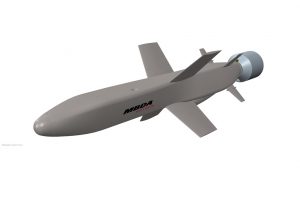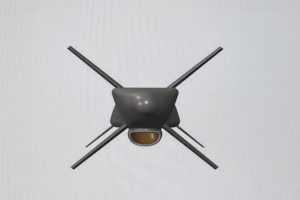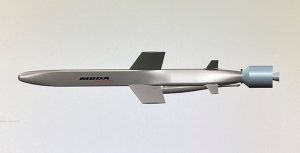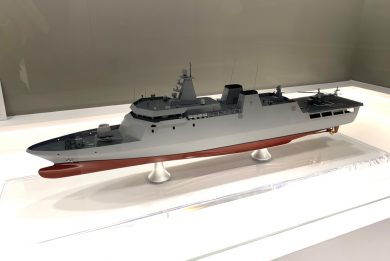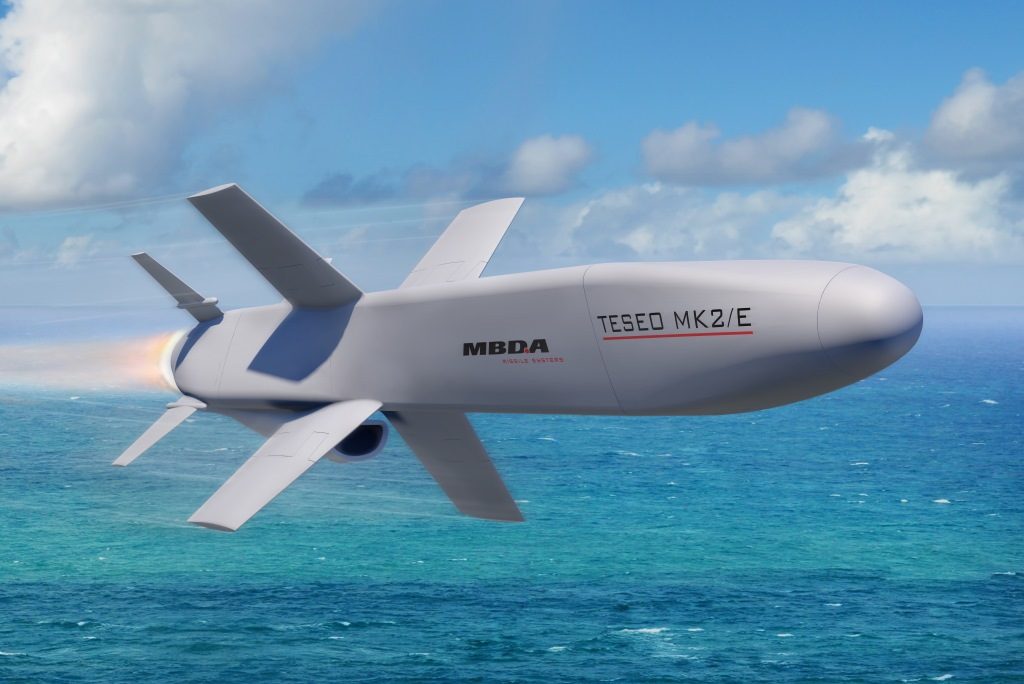
MBDA details its new Teseo Mk2/E anti-ship missile
By Luca Peruzzi
Building on the family of legacy Teseo anti-ship missiles with land-attack capabilities, known worldwide as Otomat, alongside present and future technology developments, MBDA will provide the Italian Navy with the new generation Teseo Evolved weapon system, namely Teseo Mk2/E. The release by MBDA of a technical brochure in addition to the press release issued on 17 March, allow EDR On-Line to make a first analysis on the new generation missile.
‘The Teseo Mk2/E is the response’, according to the MBDA document, ‘to the operational need for shipborne application, facing threats evolution in the next twenty years and more’. The new missile embodies state-of-the art technologies, capable to operate in both maritime and land strike scenarios. It will progressively replace the in-service Mk2/A which, although subjected to overhaul activities, needs to be replaced to cope with new requirements and opponents defences. The Mk2/A overhaul will allow the Italian Navy to perform its anti-ship operational missions during the development phase of the Mk2/E. The new missile is being developed, and in the future will be produced, by MBDA Italia at its ASuW weapon system centre of excellence in La Spezia, which in the past gave life and support to the Otomat, Marte Mk2 and more recently Marte ER missiles families. The other two MBDA Italia’s sites, Rome and Fusaro will be involved in the development of the guidance seeker.
Although no details have been issued by MBDA on the contract scope, according to information provided by the Italian MoD Multi-year Planning Document (Documento Programmatico Pluriennale, DPP) 2020-2022 published last October, EDR On-Line understood it covers the design, development, testing, qualification and industrialization of the new weapon system as part of the first phase of the programme. EDR On-Line also understood the contract, which was signed in late November 2020, will last 6/7 years up to the missile industrialization milestone. According to DPP 2020-2022, the first phase of the programme, which received the approval of the Italian Parliament late last year, requires €198 million of which €150 million funded. According to the same documentation presented in Parliament, the second phase of the programme regarding the life extension of in-service Mk2/A munitions, alongside the production of the new Mk2/E weapon is to run progressively in coherence with the development timeline of the new missile, to mitigate any potential and significant gap in the anti-ship capability of the Italian Navy. According to DDP 2020-2022, the overall programme requested budget is stated at €406.5 million, including the logistic support for the first decade.
“The Teseo Mk2/E has been defined and designed thanks to an intense collaboration between the Italian Navy and MBDA. This new anti-ship missile will mark a step-change in the Otomat/Teseo family, allowing it to keep up with ever evolving threats, and will feature advanced functions to support Italian Navy operations that will significantly increase the flexibility and operational value of its surface ships,” said Lorenzo Mariani, Executive Group Director Sales and Business Development and Managing Director MBDA Italia, commenting the announcement of the programme.
To satisfy Italian Navy requirements, MBDA Italia has conceived a completely new long range weapon system with an advanced dual-mode homing head and a state-of-the-art scalable warhead, relying on an advanced mission planning system, with a full mission control of the missile flight.
Based on released information and computer images, the Teseo Mk2/E will feature a transonic airframe with a completely new shape, alongside aerodynamic and flight control enhancements to provide increased manoeuvrability and survivability. The radar cross section is also expected to be controlled through shapes and possibly absorbing materials, while a new efficient propulsion package will increase the weapon range. According to MBDA, the MK2/E model will have ‘high-subsonic cruise speed and high-G terminal manoeuvrability with an effective range in excess of 350 km at sea-skimming level’. According to an author’s interview with the then head of the Italian Naval Armament Directorate in late 2019, this increased range would be obtained thanks to the adoption of a low bypass turbofan of undisclosed type, with structural fuel-tank and a new anti-g system package. Asked to confirm this information, MBDA didn’t answered.
The less than 5 meters long airframe, which EDR On-Line understood being composite-made, has a forward inverted trapezoidal-shaped section while the aft part has a trapezoidal section to reduce the overall weapon system radar signature with midsection X-arranged foldable fixed-wings, a ventral inlet for the turbofan engine and four rear moving foldable surfaces and actuators to control the missile. The new weapon system features a single coaxial booster compared to the solution with two smaller boosters on the missile sides used by the Otomat family, with an overall length in the launching canister of less than 5.5 meters. The new powerful booster will be provided, EDR On-Line understood, by Avio of Italy which also contributes to Aster and more recently CAMM ER propulsion systems. This architectural solution not only reduces the missile installation footprint but facilitates a future potential deployment from vertical launching systems.
According to information provided during the Parliament programme approval process, the missile system for the Italian Navy will use a new single-shot canister compatible with current Otomat inclined launcher platforms. According to obtained information, it is square in size, features a frangible forward cover, and is based on Marte ER developments, making it significantly lighter than the Otomat re-usable canister. According to MBDA, the Teseo Mk2/E is suitable for installation on ships of any tonnage, and can be employed as part of coastal defence systems, further enlarging the potential customers market.
According to MBDA documentation, the weight of the missile ‘at the beginning of the cruise phase’, and therefore without the booster, is of 700 kg.
To cope with latest and future mission requirements to operate in complex scenarios such as the littoral environment, populated by shipborne and land-based air defence missile systems and electronic countermeasures, alongside with the maritime traffic on sea lines of communication as well as populated areas on land, the Teseo Mk2/E will feature, EDR On-Line understood, a state-of-the-art navigation and guidance systems centered on a new weapon control system with open architecture for further developments, together with a fully autonomous integrated INS/GPS. According to Parliament documentation this will feature the latest anti-jamming capabilities, will be compatible with both US and future EU Galileo constellations, and will include an advanced adaptive radar altimeter and a new-generation two-way data link system. The Italian MoD paid particular attention to operations in congested crisis areas providing the capability to control the missile mission up to the end of the engagement. MBDA Italia added a new miniaturized two-way data link system providing a state-of-the-art capability, relying on military satellite communication constellation, and focused on target update and reassignment, as well as mission abort.
According to MBDA the terminal guidance is provided by a ‘state-of-the-art dual mode head section including both new coherent RF (radio-frequency) seeker with ECCM capability and E/O sensor for high precision engagement, for sea and land targets’. During the recent annual press conference with Italian journalists, Lorenzo Mariani, Executive Group Director Sales and Business Development and Managing Director MBDA Italia, explained that the contract indicates the new missile is to be equipped with a state-of-the-art but conventional RF seeker. However, as part of the same contract, a feasibility study was launched to verify in an already quantified but publicly undisclosed timeframe compatible with the missile development, the possibility to equip the new weapon system with an AESA (Active Electronically Scanned Array) seeker. The alternative solution would remain the conventional state-of-the-art seeker. The MBDA representative however highlighted that the company together with Leonardo, as the feasibility study is a common activity between the two groups, is accelerating it to demonstrate the feasibility and provide the cost estimates associated with the new solution. Although Mariani hasn’t elaborated in this contest, MBDA Italia has previously disclosed it has been working on new generation AESA-equipped seeker demonstrators. An undisclosed funding amount, according to the MBDA representative, is already allocated to the project but not contracted, while the estimated remaining requested funding is still to be found. The MBDA representative didn’t considered the remaining funding allocation as an issue due to the reduced costs compared to the whole programme but mostly important as the latter capability is a ‘game changer’ and key for maintaining industry cutting edge technology and national sovereignty, allowing Italy to offer the new generation seeker for future multinational programmes, namely the FC/ASW (Future Cruise/Anti-Ship Weapon) to which the Italian MoD has shown interest for the future.
Technological trends indicate that the seeker’s Ku-band is the most suitable for anti-ship scenarios with potentiality significant performance evolutions thanks to an architecture compatible with evolved front-end, namely the AESA antenna. No further details were provided about the feasibility study but EDR On-Line understood that MBDA and Leonardo have signed a partnership, supported by Italian MoD and Navy, for the development of the next generation AESA-based Ku-band seeker, Leonardo providing the AESA antenna and MBDA Italia the wideband digital receiver/processing back-end.
The other (E/O) sensor installed as part of the terminal guidance system is a semi-active laser (SAL) channel, allowing a highly precise engagement with third parties support of both land- and littoral-based targets, hence considerably reducing potential collateral damages.
The latter capability, together with the new two-way data link system provides, according to MBDA, ‘high hitting probability, even against fast moving targets at range’.
Another newly developed key component for the Mk2/E model is the ‘effective scalable semi-piercing/high explosive warhead’, says MBDA. Expected to be in the same 200 kg-range weight of the Teseo Mk2/A lethal package, the new insensitive warhead offers enhanced neutralization capabilities, and is fitted with an impact and proximity fuse. Together with the SAL guidance, the scalable warhead will contribute to plan missions in highly congested and populated areas.
The Teseo Mk2/E will also have an advanced mission planning system, with 4D way-points (space and time) with programmable time on target, as well as reduced reaction time to few seconds from mission preparation to target engagement in full controlled conditions,. Planned mission parameters can be modified during the mission according to the real time tactical picture. The mission planning will also offer salvo capability with simultaneous time on target (STOT) attacks. Thanks to the new navigation/guidance suite the new missile is indicated as ‘self-adapted sea skimming, with over-land fly capabilities’, allowing for a mixed sea-land overfly mission profile.
The Teseo Mk2/E missile system will equip the next generation destroyer (DDX) and could replace the current Mk2/A version onboard FREMMs and Horizon type destroyers, said MBDA. The new multi-purpose combatant offshore patrol vessels (PPA – Pattugliatori Polivalenti d’Altura), currently in production, are already fitted-for Teseo Mk2/E installation. The long-range and dual-role capabilities together with the scalable warhead and mission control over full flight are key features that are expected to attract not only Otomat family users but also additional potential customers worldwide.
Images courtesy MBDA

